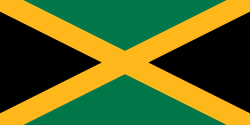 The flag of Jamaica | |
| Data | |
|---|---|
| Water coverage (broad definition) | 93% |
| Sanitation coverage (broad definition) | 81% |
| Share of household metering | 66% [1] |
| Share of self-financing by utilities | Zero |
| Institutions | |
| Decentralization to municipalities | No |
| National water and sanitation company | Yes |
| Water and sanitation regulator | Yes (multi-sector) |
| Responsibility for policy setting | Ministry of Water and Housing |
| No. of urban service providers | 1 large, 3 small |
Water supply and sanitation in Jamaica is characterized by high levels of access to an improved water source, while access to adequate sanitation stands at only 80%. This situation affects especially the poor, including the urban poor many of which live in the country's over 595 unplanned squatter settlements in unhealthy and unsanitary environments with a high risk of waterborne disease. Despite a number of policy papers that were mainly focused on water supply and despite various projects funded by external donors, increases in access have remained limited (1% for water and 5% for sanitation between 1990 and 2004).
Contents
- Access
- Service quality
- Infrastructure
- Responsibility for water supply and sanitation
- Policy and regulation
- Service provision
- Other
- Economic efficiency
- Financial aspects
- Tariffs and cost recovery
- Investment and Financing
- External cooperation
- Inter-American Development Bank
- World Bank
- Japan Bank for International Cooperation (JBIC)
- United States (USAID)
- See also
- Sources
- References
- External links
The responsibility for water and sanitation policies within the government rests with the Ministry of Water and Housing, and the main service provider is the National Water Commission. An autonomous regulatory agency, the Office of Utilities Regulation, approves tariffs and establishes targets for efficiency increases.
